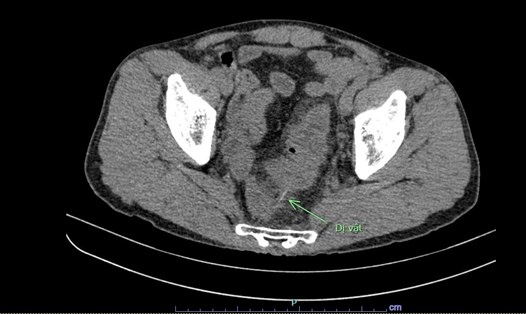50-year-old male patient, no relatives living with him, 26-year history of schizophrenia, regular treatment at Nam Dinh Provincial General Hospital.
According to the patient's family, 2 weeks before being admitted to the hospital, the patient swallowed 3 lighters and had an endoscopy to remove the foreign object. This time, the patient was admitted to the hospital because of increasing abdominal pain and bloating. Through clinical examination, the abdomen was found to be distended, with pain in the lower abdomen and a strong reaction.
Abdominal CT scan showed 2 metal-tipped rod-shaped foreign bodies in the intestinal loop in the hypogastric region, penetrating the intestinal wall to create an air-filled pocket in the pelvis next to the right obturator muscle; Foreign body in the right hypochondrium intestinal loop; Thickening of the rectal wall, sigmoid colon and transverse umbilical intestinal loop; Diffuse dilation of the small intestinal loops.
The patient was diagnosed with an intra-abdominal abscess due to perforation of the sigmoid colon due to a foreign body, small intestine foreign body/schizophrenia. The patient underwent emergency surgery: opening the small intestine to remove the foreign body (ballpoint pen, pen refill, plastic toothpick), cutting the section of the sigmoid colon perforated by the foreign body, closing the lower end, bringing the upper end out of the abdomen to create an artificial anus.
After surgery, the patient is stable and will have to undergo another surgery to close the colostomy and restore the digestive tract. Prevention and monitoring of the patient is an issue after surgery to avoid recurrence of foreign body ingestion. If it happens again, it will be very difficult to handle.
Dr. Le Van Duy - Digestive Surgery Center, Bach Mai Hospital said: Pica syndrome is an eating disorder in which the patient has an appetite and eats non-food items, such as rocks, animal feces, hair, paper, metal objects, or other materials that have no nutritional value.
Pica can occur in children, adults, pregnant women, or people with developmental disorders, such as autism, intellectual disability, or neurological disease. Causes of pica can include nutritional deficiencies (such as iron or zinc deficiency), psychological stress, psychiatric disorders, or other health problems. Although not a common disease in the general population, if left untreated, pica can lead to serious health problems such as poisoning, inflammation, obstruction or perforation, gastrointestinal tears, infection, local and systemic toxicity that can lead to death.
In the case of the above patient, there are no relatives living with them, so it will be very difficult to monitor them. In this case, it is necessary to establish a monitoring plan, if possible, hire a caregiver, use surveillance technology (cameras in the kitchen, bedroom, etc.) to monitor unusual behaviors. If not, you can contact community organizations, local authorities, and residential groups to support monitoring for patients without relatives in combination with other preventive measures.










